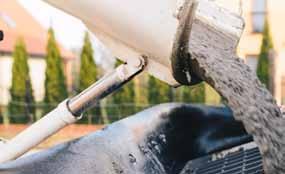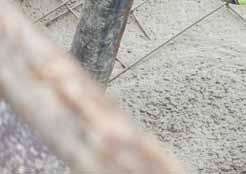
9 minute read
Concrete Plans
vehicle, meaning there is little chance of spillage or dropped concrete on site. • with its wider reach, contractors can get concrete to inaccessible places: The hose or boom of concrete pumps can place concrete precisely in hard-to-reach areas, such the top of high-rise buildings, enclosed buildings, over fences, and down steep slopes. How far can a concrete pump truck reach? The vertical reach of a boom pump is 42m, and its horizontal reach 38m. Even longer booms exist. • Pumping of concrete is done before the
concrete starts to set, improving con-
Advertisement
crete strength: This can guarantee a more accurate result. There should be fewer stoppages, delays and in general it will result in a more even and polished finish. overall, concrete pumping is a more convenient method that a traditional mix and pour method of transferring concrete.
• Pipelines go wherever you want them to go: Concrete pumps can be used on a wide range of building sites – from largescale commercial developments to small residential properties. When used alongside volumetric mixers, they can be scaled up or down to suit the individual requirements of a project. Where a high volume of concrete is required to be delivered within a short time, multiple pumps can meet the demand. For lower-volumes projects, the volumetric mixer batches precisely the amount of concrete you need (which reduces waste), and the pump can pour this just as efficiently as it would for higher volumes. It is a flexible and affordable solution that can be easily tailored to suit a project’s unique needs.
Several pumps can pour simultaneously for larger projects how fast the concrete can be poured is an important aspect of any construction job. using a concrete pumping method means that concrete can be poured at a much faster rate than other pouring methods. With faster placement, the project can move quickly and this will help you stay within your project deadlines. • it is effective and economical for various
sized projects, including residential and commercial
• Concrete pumping has a large applica-
tion, including foundations, slabs, columns, bridges and dams
DOwNSiDES OF CONCRETE PuMPiNg
There are downsides to concrete pumping, though many of them are preventable and fixable. For instance, there is always the possibility of a concrete pump breaking down, a major headache when there is a queue of ready-mix concrete trucks delivering concrete. Most of the time the breakdown is resolved within a few minutes.
Then there is always the risk of injury to construction workers and damage to property. Concrete pumps are heavy machinery and as a result, there is always the chance of things going seriously awry. Fortunately all concrete pump operators are highly trained. No person is allowed to drive or operate a concrete pump without proof of operator training. All crew members working on concrete pumps are also trained in general health and safety.
Finally, during busy periods it is not always easy to find an available concrete pump. Therefore, advance planning is essential if a contractor wants one, especially before holiday periods. n
Concrete pumping by far outweighs the traditional method of placing concrete
By Eamonn Ryan
Asafe concrete pumping operation is one with a plan. It consists of a secure workplace, proven processes and well trained people. These are achieved through processes, minimum standards and recommended best practices. Systems and processes within a concrete plan form the foundation of compliance.
Planning permits sustainable continuous improvement by systems and processes that direct and guide actions in a systematic manner and requires thorough documentation. At best, a quality management system such as ISo 9000 would provide a suitable structure for the processes.
RiSK ASSESSMENT AND MANAgEMENT
Considering the nature of pumping activities, there are a number of hazards that need to be identified so as to best mitigate their risks. Some of these hazards are common to other site operations, so the processes and activities associated with these risks are not unknown but still need to be identified at the various stages of the operation. Minimum standards need to be in place to mitigate the risks presented by the more significant hazards prevalent in concrete pumping, and we suggest some herein.
The challenges on each construction site are unique – varying from one job site to another and therefore requiring a basic risk assessment for each site to identify the hazards and their potential impact. Typically most significant hazards are informed from past incidents, and would include vehicle and traffic movements, working at heights and working in the proximity of power lines. A basic risk assessment carried out by a competent person at each site where a pump is to be established for the first time will reveal the exact nature of these hazards. The risk assessment aims to identify individual risks presented by any site-specific hazards which can be added to the pre-start-up check. lack of awareness of site-specific hazards leads to accidents, and the minimum standard should therefore be that a risk assessment be carried out by a competent person for every site where a pump is to be established for the first time.
PRELiMiNARy SiTE CHECK
To ensure a proper concrete plan for each pump job, the operator shall plan and carry out a check in accordance with established oH&S minimum procedures, making use of templates to establish that all the preparation, equipment, material, route planning and administration is in place. Deviations need to be recorded and forwarded to the operator’s supervisor or maintenance function for resolution.
A lack of systematic planning can result in disruption or discontinuity in service which would place the pumping team under undue pressure, possibly resulting in an accident. The minimum standard would consequently be for

the operator to carry out a pre-departure checklist recording deviations and inform the supervisor or maintenance function to ensure that deviations are resolved.
The concrete plan should be structured to uncover potential hazards involving concrete pumping as well as any other potential hazards and record them on documentation that is readily available and visible to the supervisor and pump operator. Each hazard should receive particular attention in the risk assessment for the first pump establishment on the site and subsequent observations and toolbox talks. risks include unexpected and/or uncontrolled hazards arising from pumping activities resulting in injuries, and the best practice is for potential hazards relating to pumping to be established as a part of routine order taking and communicated to the concrete pumping team. before establishing the pump on site, the supervisor or pump operator should thereafter be familiar with the risk assessment for the site. The individual should walk around the relevant areas of the job site and follow up with a talk to staff and the responsible person on site for the concrete placement and cover aspects such as: • Access to the structure/working at height • Location and building of pipelines • Stability of working platform (scaffolding and formwork) • Exclusion and danger zones • Communication between the operator, drivers and placing team leader • Edge protection (or lack of) and openings when working at height • Handling of the discharge hose
regarding clean-up options for the pump on the job site, the risk exists that a lack of planning could result in injury due to unsafe conditions at the workplace. In this instance, best practice suggests that before establishing the pump, the supervisor or pump operator should walk the job site, make contact with the responsible person for the concrete placement and should conduct a technical talk with his team where applicable.
SAFETy OBSERVATiON wALKABOuTS
To remain familiar with conditions on site as well as challenges facing the pump operators, the supervisor or manager should conduct safety observation walkabouts to record their observations both of good practices and of any opportunities for improvement. A tour would include discussions with the responsible person for concrete placement on site and the pump operator, they being best placed to understand the potential risks involved.
Such observations should include a basic check of the quality of scaffolding and support work of the formwork throughout the job site. Such risks include a lack of cross-bracing, overextended jack screws and irregular support loads on scaffolding that could lead to instability and potential collapse of a concrete deck during placement – thereby putting the lives of the pump operator and site crew at risk.
As a lack of routine monitoring could result in lack of awareness of unsafe working conditions on site, best practice suggests that supervisors or managers conduct site observation walkabouts and record their observations of good practices and opportunities for improvement.
Wherever a risk assessment or site observation has evaluated that it is unsafe to proceed with pumping work, the competent supervisor should cease pumping operations, further assess the situation and immediately resolve the problem by implementing safe interim controls. This aims to reduce the risk to an acceptable level, or to escalate the issue to the line manager for further instruction.
Identified hazards and risks that are not controlled, result in isolated and unsafe operating conditions, and best practice suggests that where work has been assessed to be unsafe, a competent manager or supervisor shall take control of the situation and determine a suitable outcome. n
Operational and maintenance procedures
The following section deals with operational and maintenance procedures necessary for a safe pumping operation under a concrete plan.
It is common for manufacturers to outsource pumping to a third party concrete pumping service. Where this service is under the manufacturer’s direction and offered to their own customers, it is common that the manufacturer’s Contractor Safety Management rules apply. In principle the same oH&S rules that apply to its own employees would also apply to third party contractors.
Maintenance of equipment should be completed to a high standard carried out as per manufacturers specifications and conducted by a competent technician as part of a planned maintenance schedule designed in consultation with the equipment supplier for the vehicle, pump and boom.
Pump equipment and component failure may result in accidents or pipeline blockages placing pressure on the crew due to delays to effect repairs. Consequently, minimum standards of a cement or equipment manufacturer requires that a maintenance procedure and schedule shall be established in conjunction with the equipment supplier. • Checklist for pump pre start-up: An operator pre start-up checklist is common for the operation of most key items of equipment.
This is particularly important for a concrete pump so as to ensure that any items requiring attention are in fact scheduled for maintenance or repairs. The risk exists that a lack of attention to items that require maintenance or repair leading to pump component failure or pipeline blockage. A typical minimum standard would cover an operator carrying out a pre start-up check making use of a standard check sheet, record deviations and forward to his supervisor and/or maintenance function for the scheduling of repairs.










